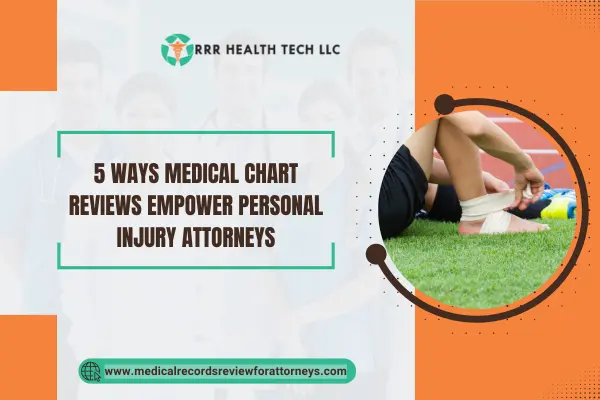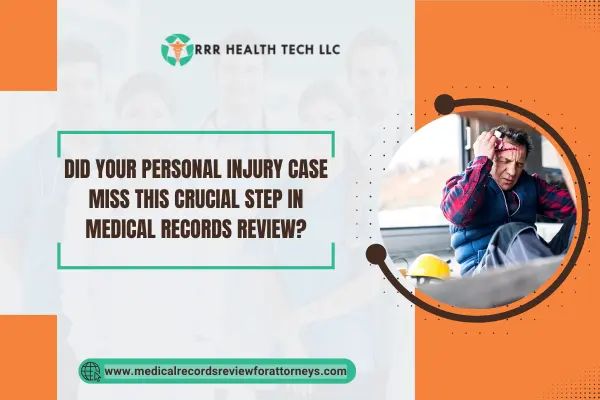
Introduction
Injuries to an employee in the workplace have far reaching consequences, both for the worker and his family. Although workers’ compensation plans are meant to help the injured workers so that they do not suffer too much, there are instances where third party liability claims may help. This article seeks to answer several questions relating to third party liability claims in workplace injuries, how these claims differ from workers’ compensation claims, and how our medical records review services can help lawyers win cases in court.
What is Third Party Liability?
Definition and Overview
• Third Party Liability: This is a legal term which defines injuries suffered by an employee as a result of a decision by a party unrelated to the employee or the employer. Negligent injury claimants include, but are not limited to, manufacturers, contractors, or any other entity that, through negligence, caused the employee to suffer the injuries.
• Legal Framework: Most claims for injuries suffered due to negligence do not require proof of intent or wilfulness of disregard. All that is required is that the sufferer of the injury must testify that there was reasonable care neglected by the harming party involved.
Key Differences between Workers’ Compensation and Third Party Liability
• Workers’ Compensation: A particular compensation payment system which has no prerequisite or limit of blame being placed on the victim, such that any worker can receive any form of benefits at any time, although they are restricted.
• Third-Party Liability: Covers negligence claims which has the potential of larger settlements, which include pain and suffering, lost earning, and medical bills.
Ordinary Examples of Third-Party Liability Claims
Categories of Third Parties Involved
• Manufacturers: A manufacturer may be liable for injuries caused by a product defect.
• Contractors and Subcontractors: If an injury occurred because of negligence of a contractor, he can be personally sued for damages.
• Property Owners: Injuries that happen on a third-party property may result in the owner of the property becoming liable.
Illustrations of Third-Party Liability Cases
• Construction Accidents: A worker injured due to faulty scaffolding may have a claim against the scaffolding manufacturer.
• Equipment Malfunctions: An employee injured by malfunctioning machinery may pursue a claim against the equipment manufacturer.
Legal Supervision towards the Solution for an Appeal of Claims towards a Third Party Liability
Post-Injury Steps
- Seek Medical Attention: Focus on health first, and keep records of all injuries.
- Report the Injury: Inform your employer and be sure to document the incident.
- Gather Evidence: Collect photographs, statements from witnesses, and any documents that are relevant.
Claiming Against the Third Party
• Consult an Attorney: Legal assistance is necessary for dealing with the nuanced nature of third party claims.
• Claim Submission: The lawyer will help you with the proper documentation and collect evidence to support your claim.
How Medical Files Contribute to Liability Claims
Significance of Medical Records
• Complete Documentation: Medical records are necessary to support claims and prove injuries.
• Our Services: Through the review of medical records, we ensure every relevant detail is covered to aid attorneys in constructing more credible cases.
Workplace Injuries Trends and Reports (2024)
Most Recent Changes
• Greater Recognition: There is increasing awareness of the non-negligence liability claims in construction and manufacturing industries.
• Insight into the Numbers: The injuries that occur in the workplace are still increasing, according to the report made by The US Bureau of Labor and Statistics, such issues bring the need for stronger legislation to protect injured employees.
Key Figures
• It was recorded that the United States received 2.8 million reports of non-fatal workplace injuries in 2023, which showcases the risks of workplace injuries and the necessity of third-party claims.
Case Study
Case Study 1
• Case Summary: A subcontractor fails to install scaffolding distantly causing the construction worker to fall off.
• Challenges: The employee had a hard time establishing the subcontractor’s negligence while pursuing a workers’ compensation claim.
• Solutions: The attorney used our medical records review services to prepare the necessary documentation showing the worker’s injuries and treatment history, which was helpful in proving the subcontractor’s liability.
Case Study 2: Problem with equipment
• Overview of the Case: An employee was injured as a result of a piece of equipment breaking down because of a design flaw.
• Challenges: The employee was required to establish that the equipment manufacturer was negligent in maintaining safety standards in the equipment.
• Solutions: The attorney used our services to obtain comprehensive medical records and relied on expert witnesses who proved critical in understanding the magnitude of the injuries and the liability of the manufacturer.
Conclusion
Attorneys working with injured employees need to streamline their approach towards third party liability with utmost care, especially when understanding the injury sustained in the workplace. Incorporating our medical records review services ensures legal experts get adequate documentation needed to qualify and support their cases, increasing their likelihood of providing the right compensation to the clients.


